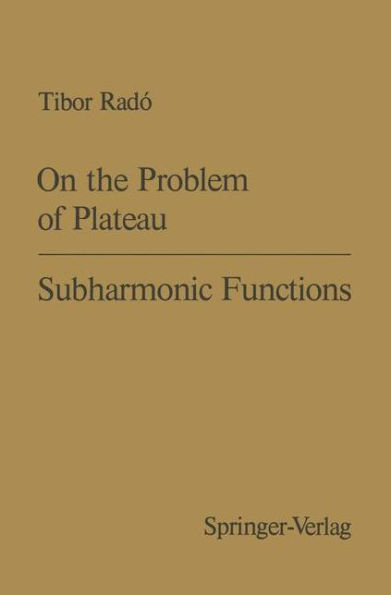On the Problem of Plateau / Subharmonic Functions
A convex function f may be called sublinear in the following sense; if a linear function l is ::=: j at the boundary points of an interval, then l:> j in the interior of that interval also. If we replace the terms interval and linear junction by the terms domain and harmonic function, we obtain a statement which expresses the characteristic property of subharmonic functions of two or more variables. This ge neralization, formulated and developed by F. RIEsz, immediately at tracted the attention of many mathematicians, both on account of its intrinsic interest and on account of the wide range of its applications. If f (z) is an analytic function of the complex variable z = x + i y. then If (z) I is subharmonic. The potential of a negative mass-distribu tion is subharmonic. In differential geometry, surfaces of negative curvature and minimal surfaces can be characterized in terms of sub harmonic functions. The idea of a subharmonic function leads to significant applications and interpretations in the fields just referred to, and· conversely, every one of these fields is an apparently in exhaustible source of new theorems on subharmonic functions, either by analogy or by direct implication.
1000907346
On the Problem of Plateau / Subharmonic Functions
A convex function f may be called sublinear in the following sense; if a linear function l is ::=: j at the boundary points of an interval, then l:> j in the interior of that interval also. If we replace the terms interval and linear junction by the terms domain and harmonic function, we obtain a statement which expresses the characteristic property of subharmonic functions of two or more variables. This ge neralization, formulated and developed by F. RIEsz, immediately at tracted the attention of many mathematicians, both on account of its intrinsic interest and on account of the wide range of its applications. If f (z) is an analytic function of the complex variable z = x + i y. then If (z) I is subharmonic. The potential of a negative mass-distribu tion is subharmonic. In differential geometry, surfaces of negative curvature and minimal surfaces can be characterized in terms of sub harmonic functions. The idea of a subharmonic function leads to significant applications and interpretations in the fields just referred to, and· conversely, every one of these fields is an apparently in exhaustible source of new theorems on subharmonic functions, either by analogy or by direct implication.
54.99
In Stock
5
1

On the Problem of Plateau / Subharmonic Functions
109
On the Problem of Plateau / Subharmonic Functions
109Paperback(Reprint of the 1st editions Berlin 1933 and 1937)
$54.99
54.99
In Stock

Product Details
| ISBN-13: | 9783540054795 |
|---|---|
| Publisher: | Springer Berlin Heidelberg |
| Publication date: | 01/04/1971 |
| Series: | Ergebnisse der Mathematik und Ihrer Grenzgebiete. 1. Folge , #2 |
| Edition description: | Reprint of the 1st editions Berlin 1933 and 1937 |
| Pages: | 109 |
| Product dimensions: | 0.00(w) x 0.00(h) x 0.02(d) |
From the B&N Reads Blog
